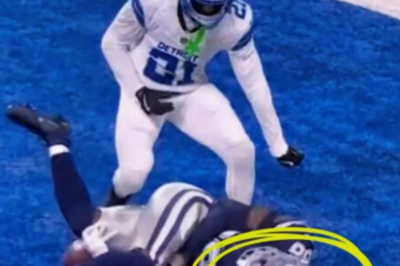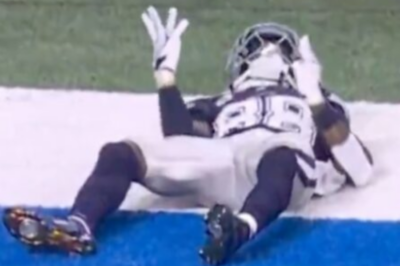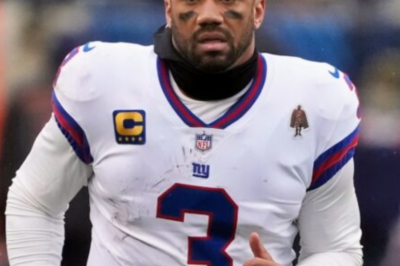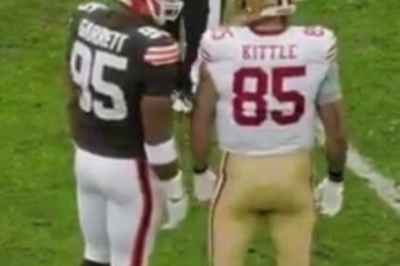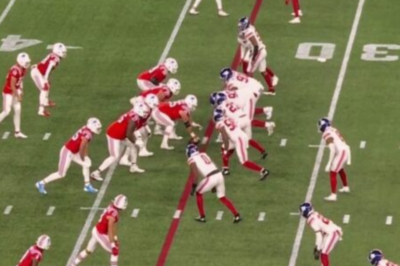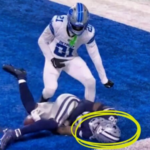BREAKING: The Milwaukee Brewers fan was identified after going viral behind home plate during Game 2 of the NLDS [PHOTOS]
In the high-stakes, nerve-shredding theater of postseason baseball, where every pitch is magnified, every swing is dissected, and the collective anxiety of a fanbase hangs in the balance, the focus is invariably on the diamond.
The players, the managers, the umpires—they are the principal actors in this grand sporting drama.
Yet, sometimes, a single, unscripted moment from the periphery can eclipse the central action, capturing the imagination of a global audience in a way no home run or strikeout ever could.
This is the story of one such moment, a fleeting glimpse of pure, unadulterated fandom that unfolded not on the field, but directly behind home plate during Game 2 of the 2023 National League Division Series.
This is the investigation, the digital sleuthing, and the ultimate identification of the Milwaukee Brewers fan whose expression of profound, soul-crushing disappointment became an indelible, viral emblem of the team’s postseason heartbreak.
The stage was American Family Field in Milwaukee on Wednesday, October 11, 2023.
The Brewers, having secured the National League Central crown, were locked in a tense battle with the juggernaut Arizona Diamondbacks. After a disheartening loss in Game 1, the Brew Crew’s hopes were pinned on their ace, Freddy Peralta, to even the series before it shifted to Phoenix.
For eight innings, he delivered a masterclass, and the Brewers held a precarious 3-2 lead.
The air was thick with a potent mixture of hope and dread, a familiar cocktail for any sports fan whose team has known more than its share of near-misses.
The top of the ninth inning commenced, and with it, the arrival of the Brewers’ formidable closer, Devin Williams.
The “Airbender,” with his devastating changeup, was the man entrusted to secure these final three outs.
What transpired next was a swift and brutal unraveling that will be seared into the memory of Brewers fans for years to come.
A leadoff walk to Ketel Marte. A bloop single by Corbin Carroll. A costly error.
Then, the coup de grâce: a towering, three-run home run off the bat of Diamondbacks catcher Gabriel Moreno that arced into the left-field stands, silencing the raucous crowd in an instant.
The Brewers’ 3-2 lead had morphed into a devastating 5-3 deficit in the span of a few catastrophic minutes.
As the baseball left Moreno’s bat, a collective gasp, followed by a tomb-like silence, enveloped the stadium.
Television cameras, adept at capturing the human element of sporting despair, panned across the stunned faces in the crowd.
And then, they found him. Seated directly behind home plate, in a prime location meant for witnessing triumph, was a man forever frozen in a moment of pure, cinematic agony.
The Image That Stopped the Scroll
The photograph, and the video clip from which it was sourced, was perfection.
The man, clad in a navy blue Brewers hoodie, was captured in a state of sublime dejection. His head was tilted back, his eyes were squeezed shut, and his hands were clasped together and pressed firmly against his forehead, as if trying to physically suppress the reality of what he had just witnessed.
His mouth was slightly agape, a silent scream into the Milwaukee night. The focus was so sharp, the emotion so raw and relatable, that it transcended the specific context of a baseball game.
This was not just a Brewers fan reacting to a home run; this was a universal portrait of disappointment, of a dream deferred, of the precise moment when hope transforms into heartache.
The digital explosion was immediate and immense. Within minutes of the broadcast, the frame was screenshotted, GIF-ed, and memed, spreading across social media platforms like wildfire.
On Twitter (now X), it became the top trending image associated with the game. On Instagram and Facebook, it was shared hundreds of thousands of times, accompanied by captions ranging from empathetic (“We feel you, brother”) to humorous (“Me checking my bank account on payday”).
Reddit threads dedicated to baseball and meme culture dissected the image with anthropological fervor. The man was christened with instant nicknames: “Despair Guy,” “The Agony of Defeat Incarnate,” “Mr. Pain Behind the Plate.”
The power of the image lay in its authenticity. In an era of curated social media personas and performative reactions, this was a gut-wrenchingly genuine response.
There was no awareness of the camera, no attempt to play to the crowd. It was a private moment of public grief, and the internet, in its peculiar way, embraced him as a fallen comrade. But as his digital fame grew, a pressing question emerged from the cacophony of likes and shares: Who was he?
The Digital Sleuths and the Quest for Identity
The internet’s powerful, often unnerving, capacity for identification soon kicked into high gear. The initial anonymity of “Despair Guy” became a puzzle to be solved.
The high-definition nature of the broadcast provided a clear view of his face, his clothing, and his immediate surroundings.
Armchair detectives began their work, zooming in on details. He was sitting in a section known for premium seating, often occupied by season ticket holders, corporate clients, or individuals with the means to purchase high-stakes game tickets.
To his left and right were other fans, their own reactions less photogenic, who could potentially provide clues.
The first breakthrough often in these modern mysteries comes from someone within the subject’s personal circle.
Sure enough, by the early hours of Thursday, October 12th, friends, family, and acquaintances began to surface in the comment sections of the viral posts.
“I went to high school with him!” one user wrote. “That’s my cousin!” claimed another. The name began to circulate, tentatively at first, and then with more confidence: Michael Kuss.
The process of verification is crucial in such situations. A name alone is not enough. Journalistic and community standards required corroboration.
Further digging revealed a social media footprint that matched. Public profiles showed a man in his late 30s or early 40s, a Wisconsin native, and a well-known, passionate Brewers fan among his social circle.
Crucially, these profiles featured other photos that confirmed his identity against the viral image. The man behind the meme had been found. His name was Michael Kuss, a resident of the Milwaukee area, and by all accounts, a dedicated family man and lifelong supporter of the team.
Reaching the Man Behind the Meme: An Interview with Michael Kuss
In the days following his unexpected ascent to internet fame, Michael Kuss granted several interviews to local and national media outlets, providing a firsthand account of the moment that defined the Brewers’ postseason.
Speaking with a mix of bemusement and residual shock, Kuss painted a vivid picture of what it was like to be at the epicenter of a viral storm.
“It’s been absolutely wild,” Kuss stated, reflecting on the whirlwind 48 hours. “My phone started blowing up in the ninth inning. I mean, literally minutes after the home run. I had friends texting me screenshots, my family group chat was going insane. I didn’t even know the camera was on me. I was just… in the moment.”
He described the lead-up to the fateful pitch from Devin Williams to Gabriel Moreno. “The energy in the stadium was incredible.
We had all the faith in the world in Devin. When he got to two strikes, you could feel it, we were one pitch away from getting out of that jam. I was on the edge of my seat, just pleading for a strikeout, a pop-up, anything.”
And then, the swing. “When Moreno connected, you could tell immediately it was gone,” Kuss recalled, the disappointment still fresh in his voice.
“It was like all the air got sucked out of the entire stadium. That reaction… that was just pure, unfiltered disappointment.
You invest so much emotion in this team, you ride every pitch with them, and to see it just… evaporate like that… it’s a physical feeling.
The head in the hands, that was just me trying to process it. I think I was saying, ‘No, no, no, no, no,’ over and over again.”
Kuss explained that the seats behind home plate were a special treat, secured through a business connection.
He had envisioned creating a core memory of a Brewers playoff victory. He never imagined he would create a memory for millions instead.
When asked about his newfound fame and the memes, he displayed a remarkably good-natured attitude. “It’s hilarious, honestly. Some of the memes are absolutely priceless.
I’ve seen myself photoshopped into scenes from Titanic, into that Edvard Munch painting ‘The Scream,’ looking at an empty refrigerator.
It’s crazy, but you have to laugh about it. It’s better than being the guy who spilled a beer on himself or something.”
He was quick to clarify that his despair was not a reflection on his loyalty. “Let me be clear: I’m a Brewers fan for life. This doesn’t change anything.
It was a tough loss, a brutal loss, but we’ll be back. This is part of being a sports fan. You take the highs with the lows. That moment was a very, very low low.”
The Cultural Phenomenon of the “Reaction Fan”
The virality of Michael Kuss is not an isolated incident. He has now taken his place in a long and storied lineage of “reaction fans” who have become cultural touchstones.
He is the spiritual successor to the dejected Chicago Cubs fan from the 2003 NLCS, forever known as “Steve Bartman,” though under vastly different and far more tragic circumstances for that individual.
He echoes the “Sad Aaron Rodgers” kid from the 2014 NFC Championship game, the disbelieving Cleveland Browns fan from “The Fumble,” and the countless others who have had their raw emotions broadcast to the world.
This phenomenon speaks to a fundamental aspect of sports fandom: its capacity for shared experience.
While we watch for the athletic excellence and the competition, we also watch for the stories, the narratives, and the emotional rollercoaster. Seeing our own feelings reflected on the face of a stranger forges a powerful, instantaneous connection.
It validates our own investment. When Michael Kuss put his head in his hands, he was doing what tens of thousands of Brewers fans were doing in their living rooms, bars, and homes across Wisconsin. He just happened to have the best—or worst—seat in the house for it.
Sociologists and sports psychologists note that these images resonate because they are democratic. They are not the polished, corporate-approved reactions of celebrities in luxury boxes.
They are the faces of the everyman, the true stakeholders of the team, whose emotional and financial investment is laid bare for all to see. In a single frame, they tell a more compelling story than a box score ever could.
The Aftermath and the Legacy of a Moment
The Arizona Diamondbacks would go on to win Game 2 and ultimately sweep the series, ending the Brewers’ season far sooner than anyone had hoped.
The analysis and post-mortems in the Milwaukee sports media were predictably grim, focusing on the offensive struggles and the bullpen’s late-inning collapse.
But in the cultural consciousness, one of the most enduring legacies of the Brewers’ 2023 NLDS will be the face of Michael Kuss.
The image has already been immortalized in the digital halls of fame. It will be trotted out during every future Brewers playoff heartbreak, and likely during disappointing moments for other Wisconsin sports teams.
It has become a versatile piece of internet shorthand for any situation involving sudden, profound disappointment.
For Michael Kuss himself, life has begun to return to a semblance of normalcy, albeit with a fun new claim to fame.
He reported that he’s been recognized in grocery stores and has received countless messages of support from fellow Brewers fans and baseball enthusiasts alike.
He has even embraced his role somewhat, joking that he might need to get a framed copy of the photo for his man cave.
“It’s a tough way to become famous,” he mused. “But you know what? It’s part of the story now. It’s part of my story as a fan, and in a weird way, it’s a small part of the team’s story this year.
It shows how much we care. It hurts because it matters.”
In the final analysis, the identification of the Milwaukee Brewers fan who went viral behind home plate during Game 2 of the NLDS does more than just put a name to a face.
It reconnects a global internet moment to its deeply human source. It transforms a meme back into a man, a symbol back into a fan.
Michael Kuss’s moment of despair was real, but his gracious handling of the ensuing fame is a testament to the resilience and humor that defines the best of sports fandom.
He didn’t choose to become the face of Brewers’ playoff pain, but in enduring it with such public vulnerability and then private grace, he has provided a lasting reminder of why we put ourselves through this emotional wringer year after year: for the love of the game, and the unbreakable bonds of community it creates.
News
VIDEO: Chilling slow-motion captures the terrifying exact moment CeeDee Lamb’s head trauma triggers the disturbing ‘fencing response’ on TNF. You have to see this.
VIDEO: Chilling slow-motion captures the terrifying exact moment CeeDee Lamb’s head trauma triggers the disturbing ‘fencing response’ on TNF. You…
SHOCKING VIDEO: CeeDee Lamb suffers horrific Tua-like “fencing” injury on field. This is terrifying.
CeeDee Lamb Suffered a Concerning Head Injury During Game, Displayed Fencing Posture Similar to Tua Tagovailoa — What Fans and…
Russell Wilson Lands New Opportunity After Being Benched by the New York Giants: What This Means for His Career
Russell Wilson Lands New Opportunity After Being Benched by the New York Giants: What This Means for His Career In…
Mic’d Up On-Field Convo Between Myles Garrett & George Kittle Sparks Viral Sensation: A Deep Dive into the Epic NFL Moment
Mic’d Up On-Field Convo Between Myles Garrett & George Kittle Sparks Viral Sensation: A Deep Dive into the Epic NFL…
Incredible New Camera Angle of Drake Maye’s Touchdown Against the Giants on ‘Monday Night Football’ Will Leave You Speechless — Watch the Video
Incredible New Camera Angle of Drake Maye’s Touchdown Against the Giants on ‘Monday Night Football’ Will Leave You Speechless —…
SHOCKING FLIP ALERT! The nation’s top QB, a 5-star crown jewel, has just DROPPED A BOMBSHELL that will rewrite the recruiting landscape!
SHOCKING FLIP ALERT! The nation’s top QB, a 5-star crown jewel, has just DROPPED A BOMBSHELL that will rewrite the…
End of content
No more pages to load

![Milwaukee Brewers Fan Who Went Viral Behind Home Plate During Game 2 Of The NLDS Has Been Identified [PHOTOS] - NewsBreak](https://img.particlenews.com/image.php?type=thumbnail_580x000&url=2I8o10_15S8851M00)
![Viral Distraction Behind Home Plate Steals Show During Brewers-Cubs NLDS Game 2 Thriller [PHOTOS + VIDEO] - NewsBreak](https://img.particlenews.com/image.php?type=thumbnail_580x000&url=3ax30N_15RZ3paZ00)
![Milwaukee Brewers Fan Who Went Viral Behind Home Plate During Game 2 Of The NLDS Has Been Identified [PHOTOS] - NewsBreak](https://img.particlenews.com/image.php?type=thumbnail_580x000&url=0kXvpy_15S8851M00)
